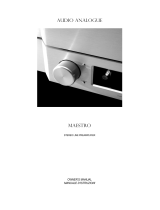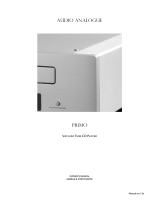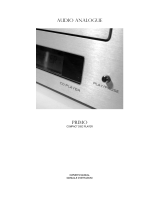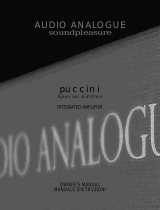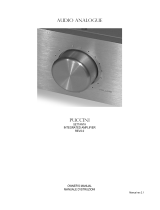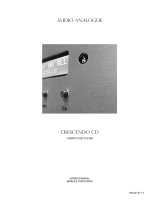Page is loading ...

4
INTRODUCTION
AUDIO ANALOGUE does not take any responsibilities in the following cases:
Whenever the operational procedures related to the use and the maintenance of the equipment as described in this manual are not
respected.
Whenever damages to the equipment occur because of fixing and modifications made form non-authorized staff or because of
normal deterioration of the system.
No part of this manual can be reproduced by any means, transmitted or copied for private or public use without private authorization
from AUDIO ANALOGUE.
The information contained in this manual is related to the data kept by AUDIO ANALOGUE at the moment of the issue o f this
publication; AUDIO ANALOGUE has the right to make changes to this document without prior notice.
The equipment has been projected and manufactured according to the Regulations of the Community 89/336/CEE and is marked CE.
This equipment can’t be used for different purposes other than those for which it has been manufactured.
AUDIO ANALOGUE does not take any responsibilities for accidents or damages due to improper use of the equipment.
WARNING
Please do respect the safety standards contained in this manual before starting to operate the equipment.
Do not open the equipment. No further interventions than those described in this manual should be made. For technical assistance,
please consult a qualified technician or an AUDIO ANALOGUE dealer.
Not respecting the instructions contained in this manual will invalidate the terms and conditions of the guarantee.
NECESSARY PRECAUTIONS FOR SAFETY AND MAINTENANCE
ATTENTION: before starting any operation, use or maintenance of the equipment it is strictly necessary to understand the following
manual.
To avoid any accidents or hazards it is necessary to follow the following regulations.
Activate the equipment only prior checking if the installation has been properly made, and if it is related to the instructions contained
in this manual.
Avoid installing the equipment in places subjected to extremely high temperatures or humidity.
Check that the labels containing information about safety are always visible and in good conditions.
Ensure to not obstruct ventilation, to avoid excessive overheating. The equipment should be kept to a minimal distance of 15 cm
from any object and not to place on carpet or other soft surfaces. Also the installation close to radiators or in close environments
without ventilation should be avoided.
Do not switch on the equipment until it has not been correctly and completely installed.
Only supply the equipment with the kind of the electric supply as stated on the appropriate label. If in doubts about the kind of supply
available, please consult an expert technician for technical assistance.
The equipment needs to be wired to an earth terminal. The external case is metal made; a defective connection with the earth may
be dangerous.
In case damages occurs to the supply cable, it should be immediately replaced with the same kind of cable. This operation should be
only made prior to disconnecting the main supply.
Do not place objects on the supply cable and check that this is not positioned in way through. The cable should not be knotted or
curly.
Replace the fuses always with other of the same kind.
Do not use the equipment close to the water or other liquids. If liquid entered the equipment, the plug should be disconnected from
the socket avoiding to touch the metal parts. Competent technical staff should be asked to check the equipment before operating it
again.
Do not place recipients containing liquids on the equipment. Even when it is switched off.
Keep the equipment far from sources of heat such as the solar light, kitchens, radiators etc…
Always unplug the supply cable during rainy weather.
Always Switch off and unplug the supply cable before cleaning the equipment externally.: this operation should be made using a dry
and soft cloth. Never use alcohol based cleaning material.
If the amplifier was carried from an extremely cold environment to and extremely hot one, it could create internal condensation,
causing possible bad functioning.
If this occurs, please wait for at least an hour before using it again, to allow it to gradually reach room temperature.
When not used for long periods, please unplug the equipment.
INSTRUCTIONS TO PUT IT OUT OF SERVICE
Consult qualified staff
Follow the regulations of the current legislation regarding recycling and waste disposal.

6
Front panel
1) Input selector. It allows you to choose the source visualizing it on the display. If you turn the knob when the unit is in standby
mode, it will switch to normal mode.
2) Volume control. Fading level is shown on the display. If you turn the knob when the unit is in standby mode, it will switch to
normal mode.
3) Standby led. It lights red when the unit is in the standby mode.
4) VFD display. It shows the pre-amplifier status or the set-up options. When Maestro Settanta is in the standby mode, the display
turns off and the led lights blue.
5) IR receiver.
Descrizione del pannello frontale
1) Selettore ingressi. Permette di selezionare la sorgente da ascoltare visualizzandola sul display. Ruotando la manopola quando
l’apparecchio è in stand by, esso ritorna nel suo stato di funzionamento normale.
2) Controllo del volume. Il livello di attenuazione viene visualizzato sul display. Ruotando la manopola quando l’apparecchio è in
stand by, esso ritorna nel suo stato di funzionamento normale.
3) Indicatore di stand by. Si illumina di rosso quando è stata attivata la modalità di stand by.
4) Display VFD. Visualizza lo stato di funzionamento del preamplificatore, oppure le opzioni di scelta del set-up. Quando il Maestro
Settanta è in stand by, il display si spegne e contestualmente si accende il led blu.
5) Ricevitore IR.

8
Remote controller
• STBY. Standby. One pressure of this button activates/deactivates standby mode. If the unit is not in the standby mode and the
button is released after a few seconds, “bypass” option is activated (check Notes on inputs bypassing section later in the
manual).
• VOL+/VOL-. Volume setting.
• MUTE. Activates/deactivates muting. When mute is activated, volume level is reduced to background level and “Mute” signal is
shown.
• IN+/IN-. Allows source selection and navigation through the set-up.
• SET. This button activates the set-up. Set-up functions are: in 1 use mode (Line, Phono MM, Phono MC), bypass source choice
and volume balance.
Descrizione del telecomando
• “STBY”. Stand-by. Attiva e disattiva lo stand-by quando viene premuto e rilasciato immediatamente. Nel caso in cui invece il
tasto venga rilasciato dopo qualche secondo e l’apparecchio non è in stand by, viene attivata l’opzione “bypass” (vedere
sezione Note sul by-pass degli ingressi più avanti).
• “VOL+/VOL-“. Regolazione del volume.
• “MUTE”. Attiva e disattiva il mute. Quando il muting è attivo il volume di ascolto viene ridotto ad un livello di sottofondo e la
scritta “Mute” viene visualizzata sul display.
• “IN+/IN-“. Seleziona la sorgente per l’ascolto e permette la navigazione nel set-up
• “SET”. Richiama il set-up. Le funzioni di set up sono: modalità di utilizzo dell’ingresso 1 (Linea, Phono MM, Phono MC), scelta
delle sorgenti di bypass e bilanciamento del volume.

10
Maestro CD 192/24
R Out L Out
UnBal
-
Bal UnBal
-
Bal
PLeft Channel
settanta
PRight Channel
s
ettanta
M
aestro Stereo
Line Pre
Back View / Vista Posteriore
Bal
R Out
L
R
PH/1 2 3 4 5
PLeft Channel
settanta
PRight Channel
settanta
R - Bal - L
Maestro
settanta
Maestro CD 192/24
R Out L Out
UnBal
-
Bal UnBal
-
Bal
6 5 4
8 7 3 2 1
Bal
L Out
4 5 6
1 2 3 7 8
Right In Left In
A) Connection with one source – Balanced Input: example Maestro CD 192/24.
A) Collegamento con una sorgente – Ingresso Bilanciato: esempio Maestro CD 192/24.
B) Use of Bypass mode: Connection to PreAmplifier + Source (example: Maestro Stereo Line Pre + Maestro CD 192/24). See
the section “ Notes on inputs bypassing ” for other informations on Bypass settings.
B) Utilizzo della modalità Bypass: Collegamento ad un PreAmplificatore + Sorgente (esempio: Maestro Stereo Line Pre +
Maestro CD 192/24). Consultare la sezione “ Note sul by-pass degli ingressi” per ulteriori informazioni sul settaggio della
modalità Bypass.
L
R
PH/1 2 3 4 5
Back View / Vista Posteriore
R - Bal - L
Maestro
settanta

11
PLeft Surround
settanta
PRight Surround
settanta
FL: Front left
FR: Front Right
LS: Left Surround
RS: Right Surround
C: Central
S: Subwoofer
PCentral
settanta
Subwoofer
settanta
Back View / Vista Posteriore
L
R
PH/1 2 3 4 5
PLeft Channel
settanta
PRight Channel
settanta
R - Bal - L
C) Use of Bypass mode: example of connection to a HomeTheatre 5.1 system. ). See the section “ Notes on inputs
bypassing ” for other informations on Bypass settings.
C) Utilizzo della modalità Bypass: esempio collegamento ad un impianto HomeTheatre 5.1. Consultare la sezione “ Note sul
by-pass degli ingressi” per ulteriori informazioni sul settaggio della modalità Bypass.
C
FR
FL
LS RS
Video Screen
Multi Channel
Audio Processor + Multi
Channel Power Amplifier
Out Left Out Right
Out
SubWoofer
Pre Out
S
Out
Central
Maestro
settanta
FL
FR

13
cercafase quale foro della presa di corrente porta la fase, e colleghi la spina dell’apparecchio in modo che il pin contrassegnato
venga inserito in quel foro.
Volume settings and silencing (mute)
The volume knob on the front panel and the Vol+/Vol- buttons on the remote controller change the general sound level. It means that
the volume of the two channels is altered identically. It is possible to modify the relative level of each channel changing the balance
option in the setup. The mute buttons on the front panel and on the remote controller allows lowering the sound level by 20dB. In
normal sound level condition, it means to pass to a background music level. This function is useful any time you have to suddenly
lower the volume, for example when you answer to a phone call or when talking with people or when changing CD in the player.
When volume is very low, pressing mute button may result in totally muting one or both unit channels, according to the balance
setting. Mute deactivating will restore the previous volume settings.
Regolazione del volume e silenziamento (mute)
La manopola del volume sul pannello frontale e i pulsanti Vol+/Vol- sul telecomando agiscono sul livello generale di ascolto. Ciò
significa che il volume di entrambi i canali viene modificato dello stesso valore. E’ possibile modificare i livelli relativi dei due canali
rispetto al livello generale di ascolto agendo sul set-up e modificando il bilanciamento.
Il pulsante di mute, sul pannello frontale e sul telecomando, permette di attenuare il livello di ascolto di 20dB. Con un normale livello
di ascolto, ciò equivale a passare ad un livello di sottofondo musicale. Questa funzione è utile qualora sia improvvisamente
necessario abbassare il volume di ascolto, per esempio per rispondere la telefono o per parlare con qualcuno o ancora quando si
desidera cambiare il CD nel lettore. Per volumi molto bassi di ascolto è possibile che l’attivazione del mute provochi il silenziamento
totale di uno o entrambi i canali, a seconda di come è regolato il bilanciamento. La disattivazione del mute ripristinerà comunque il
normale livello di ascolto
Note on Tape output
Caution, when the volume is 0, the Tape output is disconnected
Nota sull'uscita TAPE
Attenzione, quando il volume è a livello '0' l'uscita TAPE è disattivata
Note on Pre Output
Using the Maestro Settanta pre-out to drive a power amplifier or a subwoofer, in order to avoid possible noise or bump in the
speakers when you turn on the system, turn on the Maestro Settanta first and then turn on the equipment connected to the Pre
Output. When you turn off the system turn off the equipment connected to the Pre Output first and then turn off the Maestro Settanta.
Nota sull’uscita Pre
Quando si usa l’uscita pre del Maestro Settanta per pilotare un finale di potenza oppure un subwoofer, porre attenzione alla
procedura di accensione e spegnimento della catena audio per evitare possibili rumori o bump dai diffusori. Quando si deve
accendere la catena, accendere il Maestro Settanta per primo e poi accendere l’apparecchio connesso all’uscita Pre. Quando si
deve spegnere la catena, spegnere prima l’apparecchio connesso all’uscita Pre e poi spegnere il Maestro Settanta.
Notes on inputs bypassing
Maestro Settanta has a set-up option that allows using it as a power amplifier. In this case, you may choose which of the six inputs
you like to use. When this option is activated and chosen, pre-amplifier gain is reduced to 0dB and you may select the input to
bypass. Your selection can’t be changed until you deactivate this function. This option is very useful when you want to integrate the
amplifier into a multi-channel audio/video system. You could use Maestro Settanta to operate high-quality speakers also used as
front speakers in a home theatre system. In this case, the stereo sources have to be connected to Maestro Settanta, while the multi-
channel sources have to be connected to an audio/video processor. Front left and right outs of the processor have to be connected
to the Maestro Settanta line inputs, while the other processor outs have to be connected to a multi-channel terminal. When you’re
listening to a stereo source, Maestro Settanta works normally and the multi-channel processor is off. When you want to listen to a
multi-channel source, it is sufficient to turn on the processor and the multi-channel terminal and put Maestro Settanta in standby
mode holding down the “STBY” button on the remote control: Maestro Settanta becomes a real stereo power amplifier capable to
operate the front left and right speakers of the multi-channels system. In this way, you may use the high quality of Maestro Settanta
to listen to stereo source without the bulkiness (and the cost) of two different systems.
Note sul by-pass degli ingressi
E’ disponibile una opzione del set-up che permette di utilizzare il Maestro Settanta come un finale di potenza. In questo caso è
possibile scegliere quale dei sei ingressi utilizzare. Quando questa opzione è abilitata e viene attivata, il guadagno del
preamplificatore diventa unitario (0dB) e viene selezionato l’ingresso scelto per il bypass. Tale impostazione non può essere variata
finché questa funzione non viene disattivata. Questa opzione risulta essere molto utile qualora si voglia inserire questo amplificatore
in un sistema audio/video multicanale. Lo scenario ideale prevede che il Maestro Settanta piloti dei diffusori di elevata qualità che
fungono anche da diffusori frontali dell’impianto home theatre. Le sorgenti stereo vengono collegate al Maestro Settanta, quelle
multicanale ad un processore audio/video. Le uscite front left e front right del processore vengono collegate ad uno degli ingressi

14
linea del Maestro Settanta, le altre uscite del processore a un finale multicanale. Quando si ascolta una sorgente stereo, il Maestro
Settanta funziona normalmente ed il processore multicanale è spento. Quando si desidera ascoltare una sorgente multicanale, è
sufficiente accendere il processore ed il finale multicanale, e porre il Maestro Settanta in bypass premendo il pulsante “STBY” sul
telecomando per alcuni secondi: esso diventa a tutti gli effetti un finale di potenza stereo che pilota i diffusori front left e front right
dell’impianto multicanale. In questo modo si può sfruttare l’elevatissima qualità del Maestro Settanta per gli ascolti stereo senza
l’ingombro (e il cos) di due impianti distinti, uno stereo e uno multicanale.
Standby mode
You can put Maestro Settanta in standby mode pressing the “STBY” button on the remote. When the amplifier is in standby mode,
only the microcontroller section is powered while the rest of the circuit is off. In this case, the display on the front panel is off and the
power led lights blue. To exit the standby mode, just press the “STBY” button on the remote controller or turn one of the knobs on the
front panel.
Stand-by
Il Maestro Settanta può essere posto in stand-by premendo il tasto “STBY” sul telecomando. Quando l’amplificatore è in stand-by
soltanto la sezione relativa al microcontrollore viene alimentata, mentre il resto del circuito viene spento. In questo caso il pannello
frontale presenterà il display spento e il led blu acceso. Per uscire dallo stand-by è sufficiente agire di nuovo sul tasto “STBY” del
telecomando oppure ruotare una delle due manopole.
How to use the serial port
Maestro Settanta is equipped with a standard RS-232 serial port. You may remotely control the amplifier connecting to a PC or a
home-automation unit through this port. This feature allows you to integrate Maestro Settanta into a multi-room or house-automation
system. For the port settings parameters and the commands please see the table below.
Note sull’utilizzo della porta seriale
Il Maestro Settanta è dotato di una porta seriale in standard RS-232. Tramite questa porta è possibile controllare l’apparecchio
tramite un PC o una centralina per l’home automation. Questa caratteristica permette di inserire il Maestro Settanta in impianti multi-
room o di home automation. Per la descrizione dei settaggi della porta seriale e per i comandi si consulti la tabella seguente.
Description of commands for RS-232 operation
Port settings: Baud rate: 19200 Data bits: 8 Parity: None Stop bit: 1 Handshake: None
Command syntax: Parameters range Description
%AABYP,n<CR><LF> n=0..6 Enables/disables the bypass feature on the desired input ‘n’
(n=0..5: bypass enabled on line input ‘n’; n=6: bypass
disabled) Note: when enabling bypass on input 1, the line
setting is automatically selected).
%AAIN1,n<CR><LF> n=0..2 Configures input 1 mode (n=0: line; n=1: phono MM; n=2:
phono MC).
%AALIS,n<CR><LF> n=0..5 Selects input ‘n’ for listening (direct call) Note: n=0 calls for
Line 1 or Phono MM or Phono MC, n=1 calls for Line 2 and
so on.
%AALDN<CR><LF> - Selects input ‘n-1’ when listening to input ‘n’ (sequential call;
e.g.: when listening to input line 3, input line 2 is selected).
Input Tape is selected when listening to input line 1 or Phono
MM or Phono MC.
%AALUP<CR><LF> - Selects input ‘n+1’ when listening to input ‘n’ (sequential call;
e.g.: when listening to input line 3, input line 4 is selected).
Input line 1 or Phono MM or Phono MC is selected when
listening to Input Tape.
%AAMUT,n<CR><LF> n=0..1 Enables (n=1) or disables (n=0) the mute function (-20dB on
listening level).
%AASAV,dd<CR><LF> dd=00..51 Sets the listening level (volume) to value ‘dd’. dd MUST be a
two digit number.
%AASTB,n<CR><LF> n=0..1 Enables (n=1) or disables (n=0) the standby function. Note:
when n=1 the unit in in standby, thus not operative.
%AAVER<CR><LF> - Returns the firmware version number.
%AAVDN<CR><LF> - Lowers the listening level by one step.
%AAVUP<CR><LF> - Raises the listening level by one step.

16
SPECIFICATIONS
Parameter Measurement conditions Value
Channels: - 2
Line gain: 20Hz-20kHz 12dB
Phono MM gain: 1kHz 40dB
Phono MC gain: 1kHz 60dB
Frequency response:
Attenuation –10dB
Attenuation –20dB
Attenuation –30dB
100KHz
100KHz
100KHz
Noise level:
Attenuation 0dB
Band limits 0Hz-48kHz
100dB sotto 1V
Signal/noise ratio: 22Hz-22kHz >90dB
Output power:
20Hz-20kHz, 8Ohm, two piloted channels
20Hz-20kHz, 4Ohm, two piloted channels
[email protected]% THD+N
[email protected]%THD+N
Power requirement: - 100V/240V 50-60Hz
Power consumption: - 400VA
SPECIFICHE TECNICHE
Parametro Condizioni di misura Valore
Numero di canali: - 2
Guadagno stadio linea: 20Hz-20kHz 12dB
Guadagno stadio phono MM: 1kHz 40dB
Guadagno stadio phono MC: 1kHz 60dB
Risposta in frequenza:
Attenuazione –10dB
Attenuazione –20dB
Attenuazione –30dB
100KHZ
100KHZ
100KHZ
Livello di rumore:
Attenuazione 0dB
Limiti di banda 0Hz-48kHz
100dB sotto 1V
Rapporto segnale/rumore: 22Hz-22kHz >90dB
Potenza di uscita:
20Hz-20kHz, 8Ohm, due canali pilotati
20Hz-20kHz, 4Ohm, due canali pilotati
[email protected]% THD+N
[email protected]%THD+N
Alimentazione: - 100V/240V 50-60Hz
Assorbimento: - 400VA

17
TROUBLESHOOTING
Symptom Cause Remedy
Power cord incorrectly plugged
Make sure the power cord is correctly
plugged into the wall outlet
Display is off
No sound
Burned-out fuses
Check fuses in the fuse panel (after
unplugging the power cord from the wall
outlet) above the IEC inlet and replace
them with new ones of the same type
Low volume Turn volume knob right
Faulty or incorrectly plugged connectors
between Maestro Settanta and the
speakers
Check cords and their connection
Off or incorrectly selected source
Check if the source is on and active and if
it is correctly selected using the in selector
Faulty or incorrectly plugged signal
connectors between Maestro Settanta and
the sound source
Check cords and their connection
Display is on
No sound
Burned-out terminal fuses
Contact you local Audio Analogue retailer
to check and eventually replace burned-
out fuses
Recording is impossible Incorrectly selected source
Select the right source using the recording
selector
Amplifier turns off when plugged to power
outlet
One or both speakers out are short-
circuited
Check the connection of the speakers
connectors to both ends
No battery/ worn-out battery Place/replace battery (2 ‘AAA’ batteries)
Remote controller doesn’t work
You’re standing too far or on an exceeding
angle from the front panel
Get closer to the unit or reduce angle
If the suggested remedies should not work or the problem is not shown in the list above, please contact your local Audio
Analogue retailer.

19
Attention: Your product is marked with this symbol. It
means that used electrical and electronic products
should not be mixed with general household waste.
There is a collection system for these products.
Attenzione: il dispositivo è contrassegnato da questo
simbolo, che segnala di non smaltire le
apparecchiature elettriche ed elettroniche insieme ai
normali rifiuti domestici. Per tali prodotti è previsto un
sistema di raccolta a parte.
A. INFORMATION ON DISPOSAL FOR USERS (PRIVATE HOUSEHOLDS)
1 In The European Union
Attention: If you want to dispose of this equipment, please do not use the ordinary dust bin.
Used electrical and electronic equipment must be treated separately and in accordance with legislation that requires
proper treatment, recovery and recycling of used electrical and electronic equipment.
Following the implementation by member states, private households within the EU states may return their used electrical
and electronic equipment to designated collection facilities free of charge*. In some countries* your local retailer may also
take back your old product free of charge if your purchase a similar new one.
*) Please contact your authority for further details.
If your used electrical or elctronic equipment has batteries or accumulator, please dispose of these separately before and
according to local requirements.
By disposing of this product correctly you will help ensure that the waste undergoes the necessary treatment, recovery
and recycling and thus prevent potential negative effects on the environment and human health which could otherwise
arise due to inappropriate waste handling.
2. In other countries outside the EU
If you wish to discard this product, please contact your local authorities and ask for the correct method of disposal.
For Switzerland: Used electrical or electronic equipment can be returned free of charge to the dealer, even if you don’t
purchase a new product. Further collection facilities are listed on the home page of www.swisco.ch or www. Sens.ch
B. Information on Disposal for Business Users
1. In the European Union
If this product is used for business purposes and you want to discard it:
Please contact your Audio Analogue dealer who will inform you about the take-back and recycling. Small products (and
small amounts) might be taken back by your local collection facilities.
For Spain: Please contact the established collection system or your local authority foer take-back of your used products.
2. In other Countries outside the EU
If you wish to discard of this product, please contact your local authorities and ask for the current method of disposal.
A. INFORMAZIONI SULLO SMALTIMENTO PER GLI UTENTI (PRIVATI)
1 Nell’Unione europea
Attenzione: Per smaltire il presente dispositivo, non utilizzare il normale bidone della spazzatura!
Le apparecchiature elettriche ed elettroniche usate devono essere gestite a parte in conformità alla legislazione che
richiede il trattamento, il recupero e il riciclaggio adeguato dei suddetti prodotti.
In seguito alle disposizioni attuate dagli Stati membri, i privati residenti nella UE possono conferire gratuitamente le
apparecchiature elettriche ed elettroniche usate a centri di raccolta designati*.
In alcuni paesi*, anche il rivenditore locale può ritirare gratuitamente il vecchio prodotto se l’utente acquista un altro nuovo
di tipologia simile.
*) Per maggiori informazioni di prega di contattare l’autorità locale competente.
Se le apparecchiature elettriche o elettroniche usate hanno batterie o accumulatori, l’utente dovrà smaltirli a parte
preventivamente in conformità alle disposizioni locali.
Lo smaltimento corretto del presente prodotto contribuirà a garantire che i rifiuti siano sottoposti al trattamento, al
recupero e al riciclaggio necessari prevenendone il potenziale impatto negativo sull’ambiente e sulla salute umana, che
potrebbe derivare da un’inadeguata gestione dei rifiuti.
2 In paesi che non fanno parte dell’UE
Se si desidera eliminare il presente prodotto,contattare le autorità locali e informarsi sul metodo di smaltimento corretto.
Per la Svizzera: Le apparecchiature elettriche o elettroniche possono essere restituite gratuitamente al rivenditore, anche
se non si acquista un prodotto nuovo. Altri centri di raccolta sono elencati sulla homepage www.swiso.ch o di
www.sens.ch.
B. INFORMAZION SULLO SMALTIMENTO PER GLI UTENTI COMMERCIALI
1. Nell’Unione Europea
Se il prodotto è impiegato a scopi commerciali. Procedere come segue per eliminarlo.
Contattare il proprio rivenditore Audio Analogue che fornirà informazioni circa il ritiro del prodotto. Potrebbero essere
addebitate le spese di ritiro e riciclaggio. Prodotti piccoli e quantitativi ridotti potranno essere ritirati anche dai centri di
raccolta locali.
Per la Spagna: Contattare il sistema di raccolta ufficiale o l’ente locale preposto al ritiro dei prodotti usati
2. In paesi che non fanno parte dell’UE
Se si desidera eliminare il presente prodotto, contattare le autorità locali e informarsi sul metodo di smaltimento corretto.

20
Audio Analogue
Manufactured and Distributed by:
AUDIO FUTURA spa
Via Maestri Del Lavoro 583
51015 Monsummano Terme (PT) Italy
Tel. 0572 954513 fax 0572 958099
www.audioanalogue.com - info@audioanalogue.com
/
